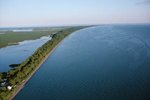Things You'll Need
State aquaculture land lease
Aquaculture grade polyester clam nets
Seed clams
Insulated box
Ice
Hard-shell clams live in bays and estuaries along the East and Gulf coasts of the U.S. Farmed hard-shell clams provide a lean source of protein for consumers. They spend most of their lives inside a two-sided shell, anchored to the bottom of a marine environment, where they use siphon tubes to filter water across their gills to obtain oxygen and food. Farmed clams eat naturally occurring plankton, so they require little input from the farmer as they grow.
Contact the local Department of Agriculture and request information regarding certifications, permits and licenses required for clam farming. Obtain all state required documents.
Research and evaluate possible marine aquaculture locations. Most coastal states use an application process to grant clam farmers leases to use specific bay and estuary locations for aquaculture purposes.

Purchase aquaculture grade polyester mesh nets and prepare them for the clams. Clam farmers often treat the mesh nets with an approved net coating to help protect the clams from predators.
Order hard-shell seed clams. Check with the local aquaculture organization to find a reputable supplier.
Receive and plant the seed clams. Take the clams to the leased submerged land, place them inside the mesh nets, securely close the nets, and submerge them. Anchor them to the estuary or bay floor.
Give the clams time to grow. In warm states, such as Florida, the clams mature in about 8 months. Further north, they may take up to 3 years to reach harvest size.
Pull the mesh nets to harvest mature clams. Store them on ice in an insulated box during transportation.
Tips
Allow plenty of time for the permitting and lease application process. Clam farmers must remove all of their equipment from the aquaculture location after harvesting their clams, or after a destructive storm event.
References
- Florida Aquaculture; Shellfish Nets and Net Coatings; Adam H. Putnam; Jan. 4, 2011
- North Carolina Department of Agriculture and Consumer Services: Aquaculture in North Carolina
- Florida Department of Agriculture and Consumer Services, Division of Aquaculture: Industry Segments
- Florida Department of Agriculture and Consumer Services, Division of Aquaculture: Aquaculture Leasing
- Maryland Department of Natural Resources: Chesapeake and Coastal Bay Life
Photo Credits
-
Jupiterimages/Brand X Pictures/Getty Images
Writer Bio
Christine Mathis is a writer, beekeeper and home gardener. Her work has included grant proposals, scientific abstracts, laboratory protocols and office work instructions. Mathis has a B.S. in broad field science and English literature with a minor in outdoor education. She is currently pursuing an M.F.A. In creative writing.



